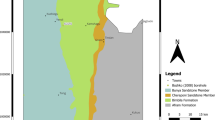Abstract
The increasing trend of population growth, freshwater demand and unscientific land use planning lead to the shortage of precious groundwater resources. Present research aims to delineate the groundwater prospect zones with the help of analytic network process (ANP) based multi-criteria decision analysis (MCDA) coupled with geographical information system (GIS) and remote sensing (RS) in Arang block of Raipur district, India. Various hydrogeological and earth surface features including aquifer, soil texture, geomorphology, slope, drainage density, land use land cover (LULC), normalized difference vegetation index (NDVI) and rainfall distribution are selected and assigned with the ANP-based weights and integrated into GIS platform by layer overlaying operation to develop the groundwater prospect zone index (GPZI) map. A total of five sub-categories of GPZI, namely excellent, good, moderate, poor and very poor are considered to understand the existing scenario of groundwater potentiality of the study area. Results indicate that about 64% of the total area having groundwater potentiality within moderate to excellent GPZI category, whereas; 36% area falls within poor to very poor GPZI category. Model accuracy measurement is verified by groundwater level data of 21 locations and the accuracy value with r=0.73 is achieved using a linear regression plot, which justifies the precision of the ANP-based model.
Similar content being viewed by others
References
Agarwal, A. and Shankar, R. (2003) On-line trust building in e-enabled supply chain. Supply Chain Management., v.8(4), pp.324–334. DOI: 10.1108/13598540310490080.
Agarwal, E., Agarwal, R., Garg, R.D. and Garg, P.K. (2013) Delineation of groundwater potential zone: An AHP/ANP approach. Jour. Earth Syst. Sci., v.122(3), pp.887–898. DOI: https://doi.org/10.1007/s12040-013-0309-8.
Andualem, T.G. and Demeke, G.G. (2019) Groundwater potential assessment using GIS and remote sensing: A case study of Guna tana landscape, upper blue Nile Basin, Ethiopia. Jour. Hydrol. Reg. Stud., v.24, pp.100610. DOI: https://doi.org/10.1016/j.ejrh.2019.100610.
Arulbalaji, P., Padmalal, D. and Sreelash, K. (2019) GIS and AHP techniques based delineation of groundwater potential zones: a case study from southern Western Ghats, India. Sci. Rep., v.9(1), p.2082. DOI: https://doi.org/10.1038/s41598-019-38567-x.
CGWB (2013) Central Ground Water Board, Government of India, Ministry of Water Resources. Ground Water Brochure of Raipur District, Chhattisgarh; Report.
Chaudhary, B.S. and Kumar, S. (2018) Identification of Groundwater Potential Zones using Remote Sensing and GIS of KJ Watershed, India. Jour. Geol. Soc. India., v.91(6), pp.717–721. DOI: https://doi.org/10.1007/s12594-018-0929-3.
DSR (2016) District Survey Report, Raipur, Directorate of Geology and Mining Mineral Resources, Department, Government of Chhattisgarh.
Gnanachandrasamy, G., Zhou, Y., Bagyaraj, M., Venkatramanan, S., Ramkumar, T. and Wang, S. (2018) Remote sensing and GIS based groundwater potential zone mapping in Ariyalur District, Tamil Nadu. Jour. Geol. Soc. India., v.92(4), pp.484–490. DOI: https://doi.org/10.1007/s12594-018-1046-z.
Ibrahim-Bathis, K. and Ahmed, S.A. (2016) Geospatial technology for delineating groundwater potential zones in Doddahalla watershed of Chitradurga district, India. Egypt Jour. Remote Sens. Space Sci., v.19(2), pp.223–234. DOI: https://doi.org/10.1016/j.ejrs.2016.06.002.
Jhariya, D.C., Kumar, T., Gobinath, M., Diwan, P. and Kishore, N. (2016) Assessment of groundwater potential zone using remote sensing, GIS and multi criteria decision analysis techniques. Jour. Geol. Soc. India, v.88(4), pp.481–492. DOI: https://doi.org/10.1007/s12594-016-0511-9.
Machiwal, D., Jha, M.K. and Mal, B.C. (2011) Assessment of groundwater potential in a semi-arid region of India using remote sensing, GIS and MCDM techniques. Water Resour. Manage., v.25(5), pp.1359–1386. DOI: https://doi.org/10.1007/s11269-010-9749-y.
Meade, L.M. and Sarkis, J. (1999) Analyzing organizational project alternatives for agile manufacturing processes: an analytical network approach. Int. Jour. Prod. Res., v.37(2), pp.241–261. DOI: https://doi.org/10.1080/002075499191751.
Pasupuleti, S., Sandilya, D.K., Singha, S., Singha, S.S. and Saha, S., (2019) Delineation of groundwater potential zones utilising geospatial techniques in Kadiri watershed of Anantapur district, Andhra Pradesh, India. Jour. Environ. Biol. v.40(1), pp.61–68. DOI: https://doi.org/10.22438/jeb/40/1/MRN-935
Saatt, T.L. (1980) The Analytic Hierarchy Process; McGraw-Hill, New York, NY.
Saaty, T.L. (1996) Decision making with dependence and feedback, The Analytic Network Process; RWS Publications, Pittsburgh.
Saaty, T.L. (1999) Fundamentals of the analytical network process. Proceedings of ISAHP 1999; Aug 12–14; Kobe, Japan; pp.48–63.
Saaty, T.L. (2004) Fundamentals of the analytic network process—multiple networks with benefits, costs, opportunities and risks. Jour. Syst. Sci. Syst. Eng. v.13(3), pp.348–379. DOI: https://doi.org/10.1007/s11518-006-0171-1.
Saaty T.L. (2007) Time dependent decision-making; dynamic priorities in the AHP/ANP: generalizing from points to functions and from real to complex variables. Math Comput Model., v.46(7–8), pp.860–891.
Singha, S., Pasupuleti, S., Singha, S. and Villuri, V.G.K. (2017) An integrated approach for evaluation of groundwater quality in Korba district, Chhattisgarh using Geomatic techniques. Jour. Environ. Biol., v.38(5), pp.865. DOI:https://doi.org/10.22438/jeb/38/5/MRN-600.
Singha, S.S., Pasupuleti, S., Singha, S., Singh, R. and Venkatesh, A.S. (2019a) Analytic network process based approach for delineation of ground-water potential zones in Korba district, Central India using remote sensing and GIS. Geocarto Int., pp.1–23. DOI: https://doi.org/10.1080/10106049.2019.1648566.
Singha, S.S., Pasupuleti, S., Singha, S., Singh, R. and Venkatesh, A.S. (2019b) A GIS-based modified DRASTIC approach for geospatial modelling of groundwater vulnerability and pollution risk mapping in Korba district, Central India. Environ. Earth Sci. DOI: https://doi.org/10.1007/s12665-019-8640-2
Acknowledgements
Authors acknowledge the support received from faculty members and authorities of ISM, Dhanbad during the research work. Authors sincerely thank organizations such as Central Ground Water Board (CGWB), Raipur, State Data Center, Raipur and Chhattisgarh Infotech Promotion Society (CHIPS), Raipur, for providing the necessary data and information utilized in the present work.
Author information
Authors and Affiliations
Corresponding author
Rights and permissions
About this article
Cite this article
Singha, S., Pasupuleti, S. Delineation of Groundwater Prospect Zones in Arang Block, Raipur District, Chhattisgarh, Central India, Using Analytical Network Process. J Geol Soc India 95, 609–615 (2020). https://doi.org/10.1007/s12594-020-1487-z
Received:
Accepted:
Published:
Issue Date:
DOI: https://doi.org/10.1007/s12594-020-1487-z




